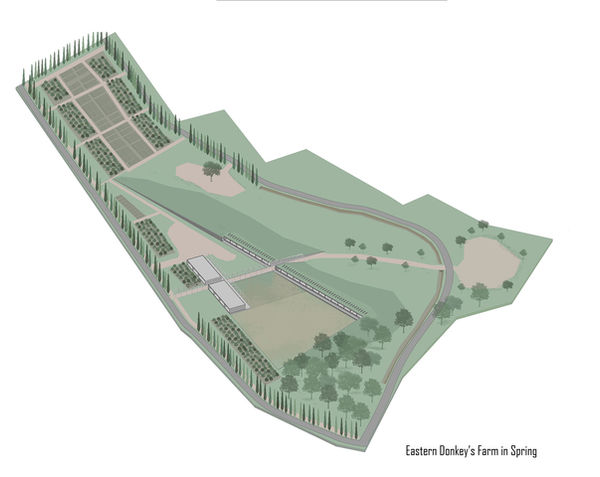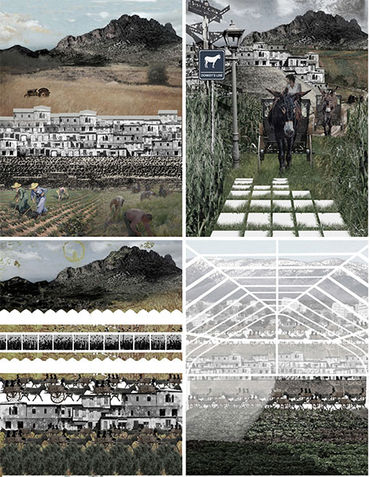Reclaim The Contested City Through Open Collectives: The Role Of University and Production Activities Around The City Walls, for a (Re)unified Nicosia
Tutors: Socrates Stratis, Chrysanthe Constantinou
2016-17
The aim of the urban design studio is twofold: Imagine a unified city supported by a network of open collective areas based on co-production and co-learning along the current dead-end ring road around the divided old city walls.
Criticize the content of the negotiations among the political leaders of the two ethnic communities of the island regarding the control of the higher education institutions. They have decided to segregate higher education by putting it under the governance of the two ethnically based states of the Federal model. For the urban design studio, the institution of the University of Cyprus is a Federal one instead of a Greek Cypriot. With its facilities, the university is invited to support the communal areas of co producing and co-learning networks around Nicosia’s old city. Currently, the University of Cyprus is located in an enclave in the city’s southern suburbs. The studio hypothesis is that the presence of a public institution around the old city may catalytically impact reconciliation and sustainability of unification. The nodes of co-production and co-learning may be catalytic in creating pockets of inclusiveness. They may support the commons in an urban environment likely to be reconstructed by the dominating neoliberal urban paradigm.
Co-producing and co-learning have guided the students’ projects. The students investigated the impact of half a century division of Nicosia on transport networks, public services and urban everydayness.
They envisioned forms of urbanity that foster collaborative spatial practices open to the rest of the city by establishing strategies of accessibility, sharing, porous edges, of introducing centralities. The studio aims to expose the students to the demanding compositional and conflictual culture of urban engagement and practice in contested territories.

Celebrating Nicosia
Team: Christos Dionysis, Christos Georgiou, Eleni Andreou, Savvas Demetriou
Nicosia is about division and separation. There are two Nicosias next to each other, with their inhabitants in isolation. The perfect circle of the Venetian city walls, cut by the divide, may be the only “unifying” element of the two sides. Since the opening of checkpoints on the UN buffer zone that separates the old city into two parts in 2003, the encounter spaces of Greek Cypriots and Turkish Cypriots who cross the divide are consumption-based (shopping malls, IKEA, gas stations, etc.). The “Celebrating Nicosia” project offers shared cultural spaces during three timelines. The first is during the current division with selective crossing, thanks to the few checkpoints. The second one is the short-term period during the city’s reunification process. The third one involves the longer-term period after the city’s reunification. During the first timeline, the two public transport networks that serve the city’s north and south are re-adjusted to become one network as soon as the city is reunified. Two urban nodes are created next to the UN buffer zone that will expand into the buffer zone territory upon reunification. A tram line is planned along the old city ring road, currently divided into two parts. The two urban nodes will attract cultural events to support the process of reconciliation. During the second timeline, the two public transport networks are connected to create one for the Metropolitan Nicosia with a new bus central station at one of the two urban nodes. The tram line along the ring road is implemented. During the long-term stage, the two urban nodes will be populated with faculties of the Federal University of Cyprus.

Donkey's line
Team: Achilleas Kourtellos, Kateryna Chrysostomou, Michalis Solomou, Paisios Skitini
The “Donkey’s Line” project seeks to modify the all-car mobility model of Nicosia by creating a city centre based on soft mobility and public transport that serve both agriculture and educational programs. The project introduces new agricultural faculties for the University of Cyprus to be located hand in hand with agricultural activities. A network of centralities instigates an active symbiosis between the emerging ecosystems. The “Donkey’s Line” project claims the UN Buffer Zone between Nicosia’s northern and southern parts. The project transforms the UN Buffer Zone (which will cease to exist after reunification) into a green area populated by rural activities. Cooperation is the underpinning of production methods. Cooperation concerns not only the inhabitants of the city’s two sides but also the likeable quadrupeds, the donkeys. The “Donkey’s Line” introduces agriculture and animal husbandry. The donkeys gain equal rights with humans since they work for eight hours (either pulling chars around the old city or helping transport in the fields), rest for eight hours and sleep for another eight. After“retirement”, they are let to graze in the fields.

Productive conversion
Team: Andreas Stroumpoulis, Andriani Yiangou, Antonis Mosfiliotis, Iasonas Skoulas
The “Productive Conversion” project addresses the potential eviction of carpentries, metallurgies and other workshops after the city’s reunification. The potential gentrification of the two sides of the old city due to the urban reconstruction will evict the workshops along the UN Buffer zone both on the south and north of the city. The project introduces an infrastructure that combines new workshops with low rent and new faculties of the University of Cyprus. The infrastructure is located in the urban nodes around the old city’s ring road. The spatial organization of the urban nodes fosters the complementarity of activities among the workers and the students.

Park, Ride & Cycle in Nicosia
Team: Antonia Stavrou, Georgia Constantinou, Marina Antoniou, Mikaella Raspa
What if the reunified old city of Nicosia is car-free? The “Park, Ride & Cycle” project offers an infrastructure of mobility and production that fosters soft mobility in the city. A series of park and cycle stations are located on the periphery of the old city. The stations are combined with university faculties and workshops on assembling all types of bicycles. The stations incorporate public spaces for the city. Urban ramps around the public space allow for the continuous movement of two-wheeled vehicles.

Can I be Nicosia
Team: Panayiota Dimitriou, George Kazanakis, Marilena Fragkou, Cleopatra Chapeli
We are located in Nicosia in 2020. The big integration step of the once divided capital is at last bringing implemented several architectural challenges to be solved for a smooth integration of the two sides into a single society. Nicosia is then defined again both spatially and socially. The great challenge of our project is to solve these city fragments through the prism of permeable and non-permeable boundaries that make the consolidation system of the city areas that are based on traffic flows, networks, activities, natural and imaginary boundaries and create or modify the urban porosity. The initial analysis includes basically the relationship of the outside and inside areas of the walls, which are bridged and programmatically create new boundaries between themselves. The aim of our intervention points is the recreation of the city limits and spaces through strategies and activities of cultivating production and university departments by seeing the city as a cyclic interaction. The main idea of cultivation consists of medical cannabis that grows in different types of spaces, such us public and even private. At the same time , there will be created an urban planning university department that will interact with the cannabis cultivation aiming to a gradual acceptance of production in the city of Nicosia. Common areas will act as a pillow between the boundaries of the area and create collectives among residents of the existing area and the upcoming people through the change of the city's current situation. At the same time , tram moves around the walls and activates different views of green spaces inside the city emphasizing in the three interference areas of our project. These areas are developed through the use of four design strategies. Initially, our first strategy is the linear element in space, through which are reshaped the existing local boundaries and they are introduced through the use of linear movement by arranging the new boundaries of the enclave. The second strategy is the production of medical cannabis within homes that allow the collective and the motivation that drives them in common practices. The third strategy consists of consolidating two or more enclaving regions and weakens the limits through their bridgework. These areas are located within and outside the walls of old Nicosia and are joined by the real and programmatic ’bridges’ as a forth strategy. Finally through the permeability limit areas for the formation of new boundaries, enclaves are formed as spaces open to the public and are activated at the height of the ground floor creating porosity. All strategies regard areas that create permeable and impermeable boundaries on the occasion of acceptance of the production through the gradual acceptance of medical cannabis process.


















































































































